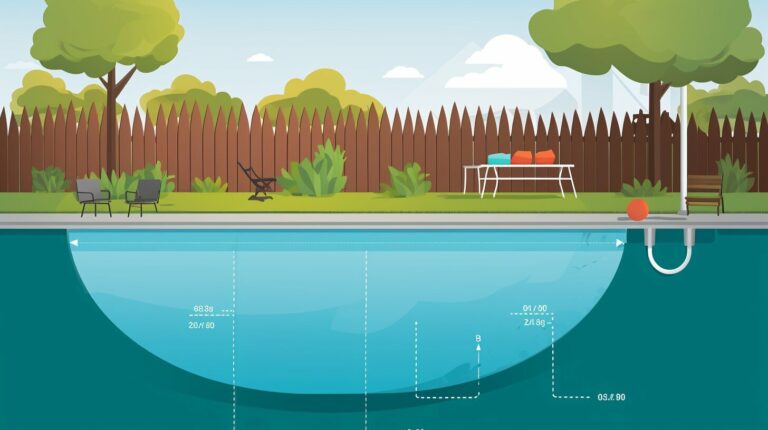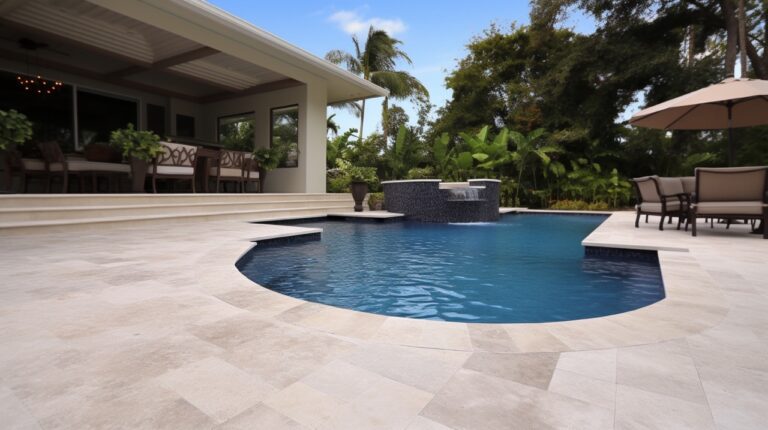Marble Vs Travertine Pool Decks: A Comparison
When we dive into the nitty-gritty of marble and travertine, we’re talking about more than just rocks; these natural stone pavers boast unique origins that define their character and use.
Marble’s transformation under heat and pressure gives it a solid yet elegant edge, while travertine’s birth from mineral-rich waters lends it an earthy charm all its own—each bringing distinct qualities to your poolside paradise.
Travertine: sedimentary rock

Travertine is a unique type of rock that comes from mineral deposits in freshwater hot springs. Over time, these deposits build up and harden into what we know as travertine stone.
Picture this: as the water flows, it carries minerals with it, especially calcium carbonate. When the water hits the air, those minerals settle out and form layers upon layers of sediments.
These become travertine—a natural wonder with its own rustic appeal.
If you’re thinking about pool decks, knowing that travertine is porous matters. It has lots of tiny holes throughout which get filled during processing to create smooth travertine pavers ready for your feet to enjoy.
But don’t forget sealing; because of those pores, treating your travertine deck with a good water-based sealant is vital to keep it looking great and safe from damage year round.
Marble: metamorphic rock

Switching gears from travertine, marble steps up as a premium choice with its metamorphic rock status. This elegant stone transforms from limestone under intense heat and pressure deep within the Earth.
The result? A durable surface that offers your pool deck a timeless look with its unique veining and selection of hues. Though marble pool decks shout luxury, they do need a bit more pampering to stay safe and stunning.
They require treatments for slip resistance since their polished finish can be slippery when wet. But persistent care pays off, giving you a resilient deck resistant to extreme temperatures—an absolute must-have for those sizzling summer days by the water.
Marble’s shiny surface may fade in constant sunlight without proper upkeep, so occasional re-sealing is crucial. Yes, this might mean more work compared to other options like travertine, but the payoff is an undeniably regal touch to your outdoor oasis—worth it if you’re aiming for kitchen countertops’ style around your swimming spot! Remember these pointers when dreaming up your perfect poolside space; choosing marble means committing to keeping it looking great season after season.
Comparing Installation, Sealing, Cost, Aesthetics, Slip Resistance, and Resilience to Natural Elements

Choosing the right material for your pool deck is like setting the stage—it’s got to look amazing, play it safe with slip resistance, and take a beating from Mother Nature without breaking a sweat.
Let’s dive into how marble and travertine stack up beyond their stunning looks—from installation hurdles to handling what the elements dish out.
Installation: easier for travertine

Travertine pool decks are a smart choice for quick and easy setup. They require less work to install than marble, making them popular among homeowners. You don’t need specialized tools or skills.
Simply lay the travertine tiles down and secure them in place.
Marble installation calls for expert hands and can take longer. But with travertine, even complex designs come together faster. This means less waiting time before you can enjoy your new deck.
Plus, you save on labor costs which can add up quickly with more demanding materials like marble.
Sealing: water-based for travertine, more resilient for marble

Sealing your pool deck is like using a shield against spills and stains. For travertine decks, water-based sealants are the way to go. They sink into those porous stones, keeping water out but letting the surface breathe.
Marble needs something stronger though – think of it as armor. This rock type shines bright but can lose its luster fast if you don’t protect it right. Use a tough sealant for marble to fight off weather wear and keep it looking timeless year after year.
Your marble deck will thank you by staying classy through all those sunny days and wild pool parties!
Cost: travertine is more economical

Travertine won’t break the bank. It’s a win for your wallet with lower material and installation costs compared to marble. This rock comes from sediment layers, which makes it less pricey than its luxurious cousin.
Homeowners on a budget find travertine an attractive option for their pool decks. You get a beautiful outdoor space without spending a fortune.
Now let’s talk about looks.
Aesthetics: rustic for travertine, timeless for marble

Moving from cost to the visual appeal, travertine and marble set entirely different moods for a pool deck. Travertine brings a warm, earthy vibe with its rustic look. Its natural tones blend effortlessly with the great outdoors, creating an inviting space around your pool.
Marble decks step into another league of elegance offering that sophisticated touch that never goes out of style. With more color options and unique patterns, marble lets you customize your poolside to suit any refined taste.
Each rock type has its own charm – it’s all about what speaks to you!
Slip resistance: natural for travertine, treatable for marble

Travertine decks won’t let you slip easily. Thanks to its porous surface, water doesn’t stand a chance. Your feet will grip even when the deck is wet. Pool owners love this natural non-slip feature because it means less worry about falls and accidents.
Marble decks need extra help for safety. Special coatings make them less slippery but remember, these treatments aren’t forever. They require regular re-application to keep your pool area safe for everyone’s wet feet.
Choose marble if you’re up for the maintenance and desire that classic look by the water.
Resilience to natural elements: extreme conditions for travertine, sensitive for marble

Marble pool decks dazzle with elegance, but they don’t love harsh weather. Sun, rain, and cold can all make marble unhappy. It might crack or lose its charm if not taken care of properly.
Travertine, on the other hand, is like a tough hiker—ready for any extreme temperature. It stays cool under hot sun making it easy to walk on around your pool.
Now think about those sudden spills or rain showers that surprise your barbecue party. With travertine, there’s no panic because it handles water just fine without being slippery. Marble needs extra help to stay safe; you’ll have to add special coatings so people won’t slip and slide after a dive into the pool.
Those treatments need refreshes now and then too!
Conclusion

Choosing between marble and travertine for your pool deck depends on what you value most. If budget and non-slip surfaces are top priorities, travertine might be the way to go. Prefer elegance and long-term luxury? Then marble could be your match.
Remember, both require professional sealing and installation. Ultimately, it’s about picking the stone that best fits your lifestyle by the pool!
FAQs
1. What’s the difference between marble and travertine for pool decks?
Marble offers a smooth, honed finish that looks sleek, but it can get slippery when wet. Travertine, on the other hand, has a more textured surface which provides better grip around pools. Both rock types bring elegance to your outdoor space.
2. Can I use any cleaner on my marble or travertine deck?
Hold up — not so fast! Avoid acidic cleaners for these stones as they can cause damage. Stick with gentler cleaning solutions to keep your deck in tip-top shape without causing abrasion.
3. Which is better for my commercial project, marble or travertine?
Travertine is often the go-to choice for commercial projects because of its durability against wear and its non-slip texture after sandblasting or abrasive blasting — both are big pluses for high-traffic areas like public pools!
4. How do I protect my pool deck from getting too hot or rough over time?
Easy! You’ve got options: lay down some outdoor mats to shield your feet from the heat and add extra protection against roughness. Plus, regular maintenance will ensure both marble and travertine decks stay beautiful year after year.





